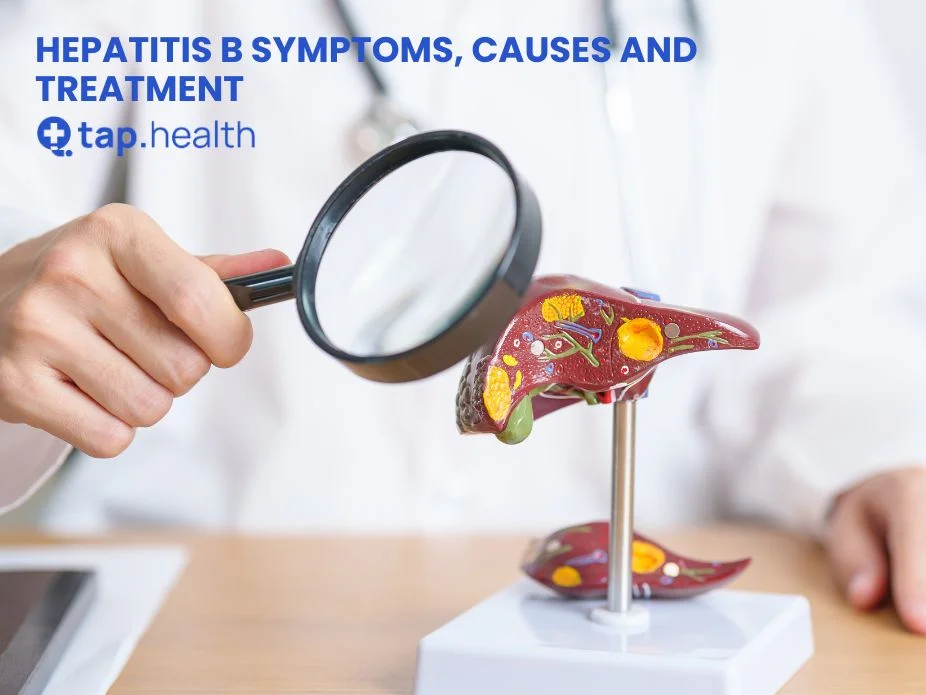What is Hepatitis B?
Hepatitis B is a viral infection that targets the liver, causing inflammation and potential damage. This condition is caused by the hepatitis B virus (HBV), which can lead to both acute (short-term) and chronic (long-term) liver disease. Hepatitis B is a significant global health issue, with an estimated 296 million people infected worldwide, according to the World Health Organization (WHO). Understanding the symptoms, progression, and management of this disease is crucial for early diagnosis and effective treatment, potentially preventing severe liver complications such as cirrhosis and liver cancer.
Types of Hepatitis B
- Acute Hepatitis B: This short-term illness occurs within the first six months after exposure to the hepatitis B virus. For many people, acute hepatitis B clears up as the immune system fights off the infection.
- Chronic Hepatitis B: When the hepatitis B virus remains in the body for more than six months, it leads to a long-term infection known as chronic hepatitis B. This form of the disease is more serious and can result in lifelong health problems, including liver damage, cirrhosis (scarring of the liver), liver failure, and liver cancer.
Common Causes of Hepatitis B
Hepatitis B is caused by the hepatitis B virus (HBV), and it spreads through contact with infectious body fluids, particularly blood, semen, and vaginal secretions. Here are some common transmission methods:
- Blood: Sharing needles or other drug-injection equipment with an infected person is a major route of transmission. Healthcare workers can also be at risk if they are accidentally exposed to infected blood through needle sticks or other sharp instruments.
- Sexual Contact: Engaging in unprotected sex with an infected person can transmit HBV. The virus can be found in semen, vaginal fluids, and blood.
- Mother to Child: An infected mother can pass HBV to her baby during childbirth. This vertical transmission is a common cause of chronic hepatitis B in regions where the virus is endemic.
- Other Routes: Sharing personal items such as razors or toothbrushes with an infected person can also spread the virus if these items are contaminated with infected blood. Additionally, getting tattoos or piercings with unsterilized equipment poses a risk.
Symptoms of Hepatitis B
The symptoms of hepatitis B can vary significantly depending on whether the infection is acute or chronic. Both phases have distinctive features that contribute to the overall clinical presentation of the disease.
Initial Stage: Acute Phase
The acute phase of hepatitis B occurs soon after infection and can last up to six months. During this period, the immune system responds to the virus, leading to a range of symptoms. However, it’s important to note that not everyone with acute hepatitis B will experience symptoms; asymptomatic cases are common, especially in younger individuals.
1. Fatigue: One of the most common symptoms is a feeling of excessive tiredness and weakness that does not go away with rest.
- Timeframe: Fatigue can appear within weeks of exposure to the virus and may last throughout the acute phase.
- Severity: The level of fatigue can vary from mild, where a person feels slightly more tired than usual, to severe, where it affects their ability to carry out daily activities.
2. Abdominal Pain: Many individuals with acute hepatitis B experience discomfort or pain in the upper right side of the abdomen, where the liver is located.
- Timeframe: Abdominal pain typically arises a few weeks after initial exposure to the virus.
- Severity: The pain can range from a dull ache to sharp, intense pain. It is often exacerbated by physical activity or deep breathing.
3. Nausea and Vomiting: Feelings of nausea, accompanied by episodes of vomiting, are common in the acute phase.
- Timeframe: Nausea often presents early in the course of the infection, appearing within weeks of exposure.
- Severity: The severity of nausea and vomiting can vary widely; some people may only feel slightly queasy, while others may experience frequent and severe vomiting that impacts their ability to eat and stay hydrated.
4. Loss of Appetite: A significant decrease in the desire to eat is another frequent symptom of acute hepatitis B.
- Timeframe: Loss of appetite generally appears soon after initial symptoms like nausea.
- Severity: This can contribute to unintentional weight loss and overall weakness, exacerbating the feeling of fatigue.
5. Joint Pain: Some individuals with acute hepatitis B experience pain in their joints, which can be mistaken for other conditions such as arthritis.
- Timeframe: Joint pain typically appears early in the infection stage.
- Severity: Usually, joint pain is mild to moderate, but it can significantly affect comfort and mobility in some cases.
6. Jaundice: Jaundice is characterized by yellowing of the skin and eyes due to elevated levels of bilirubin in the blood, a substance produced by the liver.
- Timeframe: Jaundice typically arises later in the acute phase, after other symptoms have appeared.
- Severity: The extent of jaundice can vary; in some individuals, it may be noticeable in only slight yellowing of the eyes, while in others, it may cause a pronounced yellow tint to the skin.
7. Dark Urine and Pale Stool: Changes in urine color to dark yellow or brown, and pale-coloured stool indicate liver dysfunction.
- Timeframe: These symptoms often coincide with the development of jaundice.
- Severity: These visible changes are strong indicators of liver involvement and should prompt further medical evaluation.
Chronic Phase
If the infection progresses beyond six months, it becomes chronic. Chronic hepatitis B is more serious and long-lasting, often leading to ongoing liver damage and associated complications. Symptoms in this phase can be more severe and persistent.
1. Prolonged Fatigue: Persistent tiredness that doesn’t improve with rest is a hallmark of chronic hepatitis B.
- Timeframe: This symptom is continuous and can last for months or even years.
- Severity: Prolonged fatigue can significantly impact daily activities, work performance, and overall quality of life.
2. Chronic Abdominal Pain: Constant or recurrent pain in the upper right abdomen is common in chronic hepatitis B.
- Timeframe: Abdominal pain is an ongoing symptom in chronic hepatitis B.
- Severity: The severity of the pain may vary, and it often necessitates medical evaluation and management.
3. Liver Enlargement (Hepatomegaly): Swelling of the liver, detectable during a physical exam, is a common finding in chronic hepatitis B.
- Timeframe: Hepatomegaly develops over time as the disease progresses.
- Severity: Liver enlargement indicates liver inflammation and potential damage, and it may require imaging studies for further assessment.
4. Persistent Nausea and Vomiting: Ongoing episodes of nausea and vomiting are less common but can occur in chronic hepatitis B.
- Timeframe: These symptoms can persist or recur intermittently.
- Severity: Persistent nausea and vomiting can be moderate to severe, impacting nutritional intake and overall health.
5. Unintentional Weight Loss: Loss of weight without trying, due to reduced appetite and chronic nausea, is a concern in chronic hepatitis B.
- Timeframe: Gradual weight loss occurs over time.
- Severity: Significant weight loss can lead to malnutrition and requires nutritional support.
6. Ascites: Ascites is the accumulation of fluid in the abdomen, causing swelling and discomfort.
- Timeframe: Ascites typically develops in advanced stages of chronic hepatitis B.
- Severity: Ascites is a severe symptom that requires medical intervention, often indicating liver decompensation.
7. Mental Confusion: Also known as hepatic encephalopathy, mental confusion occurs due to liver dysfunction and the buildup of toxins in the brain.
- Timeframe: Seen in advanced liver disease.
- Severity: Mental confusion is a serious symptom indicating significant liver damage and requires immediate medical attention.
8. Spider Angiomas: Small, spider-like blood vessels visible under the skin are common in chronic liver disease.
- Timeframe: These appear as the liver disease progresses.
- Severity: Spider angiomas are a sign of liver dysfunction and increased estrogen levels.
9. Edema: Swelling in the legs, ankles, and feet due to fluid retention is another symptom of chronic hepatitis B.
- Timeframe: Edema develops as liver function deteriorates.
- Severity: Edema can be debilitating and often requires medical treatment.
Treatment Options for Hepatitis B
The treatment for hepatitis B varies based on whether the infection is acute or chronic. While acute hepatitis B often resolves without specific treatment, chronic hepatitis B requires long-term management to prevent serious liver complications.
Acute Hepatitis B
Most people with acute hepatitis B recover on their own without needing antiviral treatment. Supportive care is the primary approach, focusing on relieving symptoms and maintaining adequate nutrition and hydration.
- Rest: Ensuring adequate rest is crucial to help the body fight the infection and recover.
- Hydration: Drinking plenty of fluids is important to stay hydrated, especially if experiencing nausea and vomiting.
- Healthy Diet: Eating a balanced diet with plenty of fruits, vegetables, and lean proteins supports overall health and recovery.
- Avoid Alcohol and Drugs: Refrain from consuming alcohol and avoid medications that can strain the liver.
Chronic Hepatitis B
Chronic hepatitis B requires long-term medical management to control the virus, reduce liver inflammation, and prevent complications like cirrhosis and liver cancer. The treatment plan is tailored to the individual’s condition, including the severity of liver damage and viral load.
1. Antiviral Medications:
- Nucleos(t)ide Analogues: These medications help reduce the amount of HBV in the blood and decrease liver inflammation. Common drugs include tenofovir, entecavir, lamivudine, and adefovir.
- Interferon Injections: Interferon-alpha can boost the immune system to fight the virus. It’s usually recommended for younger patients with significant liver inflammation. However, it has more side effects compared to nucleos(t)ide analogues.
2. Regular Monitoring:
- Liver Function Tests: Regular blood tests to monitor liver enzymes (ALT and AST) which indicate liver inflammation or damage.
- HBV DNA Levels: Measuring the amount of HBV DNA in the blood helps assess the effectiveness of treatment.
- Ultrasound: A hepatic ultrasound or elastography (FibroScan) helps evaluate liver stiffness and detect early signs of cirrhosis or liver cancer.
3. Lifestyle Modifications:
- Avoid Alcohol: Completely abstain from alcohol as it can significantly worsen liver damage.
- Healthy Diet: Maintain a nutritious diet, avoiding processed foods, and incorporating liver-friendly foods like fruits, vegetables, and lean meats.
- Exercise: Regular physical activity helps maintain overall health and manage weight.
4. Vaccination:
- For family members and close contacts who are not infected, vaccination against hepatitis B can prevent transmission.
5. Liver Transplantation:
- In cases of severe liver damage leading to liver failure, a liver transplant may be necessary. This involves replacing the diseased liver with a healthy one from a donor.
Home Remedies and Self-Care Tips
While professional medical treatment is crucial, certain home remedies and self-care measures can help manage symptoms and support liver health:
- Hydration: Drinking plenty of water supports liver function and helps flush toxins from the body.
- Balanced Diet: Consuming a diet rich in fruits, vegetables, whole grains, and lean proteins provides essential nutrients that support liver health.
- Avoiding Toxins: Limiting exposure to environmental toxins such as chemicals and pesticides can help reduce liver strain.
- Herbal Supplements: Some herbal supplements, such as milk thistle, are believed to support liver health, but it’s important to consult with a healthcare provider before starting any supplements.
- Rest and Stress Management: Ensure adequate sleep and manage stress through mindfulness practices, yoga, or meditation, as stress can exacerbate symptoms.
When to Seek Medical Help
Recognizing when to seek medical help is crucial for effective management of hepatitis B. Immediate medical attention should be sought if:
- You suspect exposure to hepatitis B.
- You experience severe symptoms such as intense abdominal pain, jaundice, persistent nausea and vomiting, dark urine, or pale stools.
- Mental confusion or disorientation occurs, indicating potential hepatic encephalopathy.
- Symptoms persist or worsen despite self-care measures.
Early diagnosis and intervention can significantly improve outcomes and reduce the risk of severe liver complications. A healthcare provider can perform specific tests to confirm the presence of HBV and recommend appropriate treatment options.
FAQ on Symptoms of Hepatitis B
1: Can hepatitis B be asymptomatic?
A: Yes, many people with hepatitis B do not exhibit symptoms, especially in the early stages. Asymptomatic cases are common, particularly among children and young adults.
2: How long do acute hepatitis B symptoms last?
A: Symptoms of acute hepatitis B can last from a few weeks to six months. Most people recover within this period, but some may develop chronic hepatitis B.
3: Can chronic hepatitis B lead to liver cancer?
A: Yes, chronic hepatitis B can increase the risk of developing liver cancer over time. Ongoing liver inflammation and damage contribute to this increased risk.
4: Is jaundice always present in hepatitis B?
A: No, not all individuals with hepatitis B will develop jaundice. Jaundice is more common in the acute phase and in more severe cases of the disease.
5: How is hepatitis B diagnosed?
A: Hepatitis B is diagnosed through blood tests that detect the presence of the virus or antibodies produced in response to the infection. Tests include HBsAg (hepatitis B surface antigen), anti-HBs (antibodies to HBsAg), and HBV DNA.
6: What should I do if I think I’ve been exposed to hepatitis B?
A: If you believe you’ve been exposed to hepatitis B, seek medical attention immediately. Post-exposure prophylaxis (PEP) with the hepatitis B vaccine and/or hepatitis B immune globulin (HBIG) within 24 hours can significantly reduce the risk of infection.
7: Can hepatitis B be cured?
A: While there is no cure for chronic hepatitis B, antiviral treatments can manage the infection, reduce viral load, and prevent liver damage. Acute hepatitis B often resolves on its own without treatment.
8: Are there any vaccines for hepatitis B?
A: Yes, there is a highly effective vaccine for hepatitis B. It is usually given in a series of three or four shots over six months. The vaccine is recommended for all infants, unvaccinated children under 19 years, and adults at risk of HBV infection.
9: Can pregnant women receive the hepatitis B vaccine?
A: Yes, pregnant women who are at risk for HBV infection should receive the hepatitis B vaccine. Additionally, newborns of HBV-infected mothers should receive the first dose of the hepatitis B vaccine and HBIG within 12 hours of birth to prevent transmission.
10: How can I protect myself from hepatitis B?
A: Protecting yourself from hepatitis B includes getting vaccinated, practicing safe sex by using condoms, avoiding sharing needles or personal items like toothbrushes and razors, and ensuring any tattoos or piercings are done with sterile equipment.
Conclusion
Hepatitis B is a complex and potentially serious infection that affects millions of people worldwide. Understanding the symptoms and progression of the disease is crucial for early diagnosis and effective management. The acute phase of hepatitis B can present with a range of symptoms, from mild fatigue and abdominal pain to more severe manifestations like jaundice and joint pain. For those who develop chronic hepatitis B, ongoing symptoms and the risk of serious complications necessitate careful monitoring and treatment.



